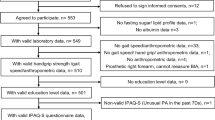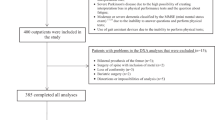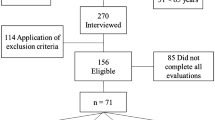Abstract
Background/Objectives:
To evaluate the prevalence of sarcopenia and osteoporosis in centenarians and its association with body composition and past physical activity (PPA).
Subjects/Methods:
We conducted an observational cross-sectional study in a representative nationwide population of 253 Portuguese centenarians. A clinically oriented questionnaire and anthropometric and body composition analysis by bioimpedance were executed. Sarcopenia was determined using a muscle mass (MM) index cutoff ⩽16.7 kg/m2. Osteoporosis was defined through estimated bone mass (BM), according to gender and body weight. Inadequate physical performance was considered when the timed-up-and-go test was >12 s.
Results:
BM and MM were gender dependent, even after adjusting for multiple variables. We found a protective effect of intense PPA on sarcopenia risk (OR=0.41, 95% CI=0.20–0.82, P=0.013). Those with worse physical function status presented a significantly higher risk for osteoporosis (OR=8.9, 95% CI=1.94–40.08, P=0.005). Multivariate models showed that low MM, BM and fat mass (FM) were predictors of underweight in centenarians. Underweight, male gender, worst physical function, hypohydration and sarcopenia were associated with increased osteoporosis risk. The risk for sarcopenia was higher in women (P=0.002), in those underweight (P=0.005) and in osteoporotic individuals (P<0.0001). Conversely, increased MM was protective against osteoporosis (P<0.0001), whereas higher BM decreased the risk for sarcopenia (P=0.005).
Conclusions:
Gender was revealed to be a relevant factor influencing BM and MM in centenarians. MM and BM were better predictors of underweight than was dehydration. Healthy BM and MM were positively related with PPA intensity and determined physical performance, having a positive impact on the centenarian’s independence. During aging, improving physical function might add to sarcopenia and osteoporosis prevention, besides prevention of femur neck fractures and cardiovascular diseases.
This is a preview of subscription content, access via your institution
Access options
Subscribe to this journal
Receive 12 print issues and online access
$259.00 per year
only $21.58 per issue
Buy this article
- Purchase on Springer Link
- Instant access to full article PDF
Prices may be subject to local taxes which are calculated during checkout


Similar content being viewed by others
References
Curtis E, Litwic A, Cooper C, Dennison E . Determinants of muscle and bone aging. J Cell Physiol 2015; 230: 2618–2625.
Baumgartner R . Body composition in healthy aging. Ann NY Acad Sci 2000; 904: 437–448.
Graf CE, Karsegard VL, Spoerri A, Makhlouf A-M, Ho S, Herrmann FR et al. Body composition and all-cause mortality in subjects older than 65 y. Am J Clin Nutr 2015; 101: 760–767.
WHO. Prevention and management of osteoporosis. World Health Organ Tech Rep Ser 2003; 921: 1–164.
Proctor DN, Iii LJM, Khosla S, Crowson CS, Connor MKO, Riggs BL . Relative influence of physical activity, muscle mass and strength on bone density. Osteoporos Int 2000; 11: 944–952.
Goodpaster B, Park S, Harris T, Kritchevsky S, Nevitt M, Schwartz A et al. The loss of skeletal muscle strength, mass, and quality in older adults: the health, aging and body composition study. J Gerontol A Biol Sci Med Sci 2006; 61: 1059–1064.
Cruz-Jentoft AJ, Baeyens JP, Bauer JM, Boirie Y, Cederholm T, Landi F et al. Sarcopenia: European consensus on definition and diagnosis: Report of the European Working Group on Sarcopenia in Older People. Age Ageing 2010; 39: 412–423.
Batsis J a, Mackenzie T a, Barre LK, Lopez-Jimenez F, Bartels SJ . Sarcopenia, sarcopenic obesity and mortality in older adults: results from the National Health and Nutrition Examination Survey III. Eur J Clin Nutr 2014; 68: 1001–1007.
Ardern CI, Katzmarzyk PT, Janssen I, Ross R . Discrimination of health risk by combined body mass index and waist circumference. Obes Res 2003; 11: 135–142.
Janssen I, Katzmarzyk PT, Ross R . Waist circumference and not body mass index explains obesity- related health risk. Am J Clin Nutr 2004; 79: 379–384.
Stenholm S, Harris T, Rantenen T, Visser M, Kritchevsky SB, Ferrucci L . Sarcopenic obesity—definition, etiology and consequences. Curr Opin Clin Nutr Metab Care 2008; 11: 693–700.
Pereira da Silva A, Matos A, Valente A, Gil A, Alonso I, Ribeiro R et al. Body composition assessment and nutritional status evaluation in men and women Portuguese centenarians. J Nutr Heal Aging 2015; 20: 256–266.
WHO Expert Committee. Physical status: the use and interpretation of anthropometry. WHO Technical Report Series, Geneva 1995; 854: 1–452.
Tanita Body Weight Science Institute. Understanding your measurements. Tanita Body Weight Science Institute 2015. Available at http://distributor.tanita.eu/about-tanita/understanding-measurements.html.
Atkins JL, Whincup PH, Morris RW, Lennon LT, Papacosta O, Wannamethee SG . Sarcopenic obesity and risk of cardiovascular disease and mortality: a population-based cohort study of older men. J Am Geriatr Soc 2014; 62: 253–260.
Shirreffs SM . Markers of hydration status. Eur J Clin Nutr 2003; 57 (Suppl 2), S6–S9.
CDC. The Timed Up and Go (TUG) test 2015. Available at http://www.cdc.gov/steadi/pdf/tug_test-a.pdf.
CDC. General physical activities defined by level of intensity, 2015. Available at http://www.cdc.gov/nccdphp/dnpa/physical/pdf/PA_Intensity_table_2_1.pdf.
Franceschi C, Motta L, Valensin S, Rapisarda R, Franzone A, Berardelli M et al. Do men and women follow different trajectories to reach extreme longevity? Italian Multicenter Study on Centenarians (IMUSCE). Aging 2000; 12: 77–84.
Liu LK, Lee WJ, Chen LY, Hwang AC, Lin MH, Peng LN et al. Sarcopenia, and its association with cardiometabolic and functional characteristics in Taiwan: results from I-Lan Longitudinal Aging Study. Geriatr Gerontol Int 2014; 14 (Suppl.1), 36–45.
Park SH, Park JH, Park HY, Jang HJ, Kim HK, Park J et al. Additional role of sarcopenia to waist circumference in predicting the odds of metabolic syndrome. Clin Nutr 2014; 33: 668–672.
Ritz P, Vol S, Berrut G, Tack I, Arnaud MJ, Tichet J . Influence of gender and body composition on hydration and body water spaces. Clin Nutr 2008; 27: 740–746.
Maresh CM, Whittlesey MJ, Armstrong LE, Yamamoto LM, Judelson DA, Fish KE et al. Effect of hydration state on testosterone and cortisol responses to training-intensity exercise in collegiate runners. Int J Sports Med 2006; 27: 765–770.
Cruz-Jentoft AJ, Landi F, Topinková E, Michel J-P . Understanding sarcopenia as a geriatric syndrome. Curr Opin Clin Nutr Metab Care 2010; 13: 1–7.
Ooi WL, Hossain M, Lipsitz LA . The association between orthostatic hypotension and recurrent falls in nursing home residents. Am J Med 2000; 108: 106–111.
Morley JE, Anker SD, von Haehling S . Prevalence, incidence, and clinical impact of sarcopenia: facts, numbers, and epidemiology—update 2014. J Cachexia Sarcopenia Muscle 2014; 5: 253–259.
Janssen I, Heymsfield SB, Ross R . Low relative skeletal muscle mass (sarcopenia) in older persons is associated with functional impairment and physical disability. J Am Geriatr Soc 2002; 50: 889–896.
Hassan-Smith ZK, Morgan SA, Sherlock M, Hughes B, Taylor AE, Lavery GG et al. Gender-specific differences in skeletal muscle 11β-HSD1 expression across healthy aging. J Clin Endocrinol Metab 2015; 100: 2673–2681.
Frontera WR, Hughes VA, Fielding RA, Fiatarone MA, Evans WJ, Roubenoff R et al. Aging of skeletal muscle: a 12- yr longitudinal study. J Appl Physiol 2014; 1321–1326.
von Haehling S, Morley JE, Anker SD . From muscle wasting to sarcopenia and myopenia: update 2012. J Cachexia Sarcopenia Muscle 2012; 3: 213–217.
Tanimoto Y, Watanabe M, Sun W, Sugiura Y, Tsuda Y, Kimura M et al. Association between sarcopenia and higher-level functional capacity in daily living in community-dwelling elderly subjects in Japan. Arch Gerontol Geriatr 2012; 55: e9–e13.
Morley JE, Argiles JM, Evans WJ, Bhasin S, Cella D, Deutz NEP et al. Nutritional recommendations for the management of sarcopenia. J Am Med Dir Assoc 2010; 11: 391–396.
Doherty TJ . Invited review: Aging and sarcopenia. J Appl Physiol 2003; 95: 1717–1727.
Yamada M, Arai H, Sonoda T, Aoyama T . Community-based exercise program is cost-effective by preventing care and disability in Japanese Frail Older Adults. J Am Med Dir Assoc 2012; 13: 507–511.
Rolland Y, Onder G, Morley JE, Gillette-Guyonet S, Abellan van Kan G, Vellas B . Current and future pharmacologic treatment of sarcopenia. Clin Geriatr Med 2011; 27: 423–447.
Montero-Fernandez N, Serra-Rexach JA . Role of exercise on sarcopenia in the elderly. Eur J Phys Rehabil Med 2013; 49: 131–143.
Beaudart C, Rizzoli R, Bruyère O, Reginster J-Y, Biver E . Sarcopenia: burden and challenges for public health. Arch Public Heal 2014; 72: 45.
Dennison E, Eastell R, Fall CH, Kellingray S, Wood PJ, Cooper C . Determinants of bone loss in elderly men and women: a prospective population-based study. Osteoporos Int 1999; 10: 384–391.
Burger H, de Laet CE, van Daele PL, Weel AE, Witteman JC, Hofman A et al. Risk factors for increased bone loss in an elderly population: the Rotterdam Study. Am J Epidemiol 1998; 147: 871–879.
Seeman E, Osteoporosis in men: The ‘Silent Epidemic’ strikes men too. Report 2004.
Demontiero O, Boersma D, Suriyaarachchi P, Duque G . Clinical outcomes of impaired muscle and bone interactions. Clin Rev Bone Miner Metab 2014; 12: 86–92.
Johnell O, Gullberg B, Kanis JA, Allander E, Elffors L, Dequeker J et al. Risk factors for hip fracture in European women: the MEDOS Study. Mediterranean Osteoporosis Study. J Bone Miner Res 1995; 10: 1802–1815.
Kanis J, Johnell O, Gullberg B, Allander E, Elffors L, Ranstam J et al. Risk factors for hip fracture in men from southern Europe: the MEDOS study. Mediterranean Osteoporosis Study. Osteoporos Int 1999; 9: 45–54.
Rosenberg IH . Sarcopenia: origins and clinical relevance. Clin Geriatr Med 2011; 27: 337–339.
van Kan GA, Rolland Y, Houles M, Gillette-Guyonnet S, Soto M, Vellas B . The assessment of frailty in older adults. Clin Geriatr Med 2010; 26: 275–286.
Dupuy C, Lauwers-Cances V, Guyonnet S, Gentil C, Abellan Van Kan G, Beauchet O et al. Searching for a relevant definition of sarcopenia: results from the cross-sectional EPIDOS study. J Cachexia Sarcopenia Muscle 2015; 6: 144–154.
Krzymińska-Siemaszko R, Czepulis N, Suwalska A, Dworak LB, Fryzowicz A, Madej-Dziechciarow B et al. The significance of body mass index in calculating the cut-off points for low muscle mass in the elderly: methodological issues. Biomed Res Int 2014; 2014: 1–8.
Beaudart C, Reginster J, Slomian J, Buckinx F, Locquet M, Bruyère O . Prevalence of sarcopenia: the impact of different diagnostic cut-off limits. J Musculoskelet Neuronal Interact 2014; 14: 425–431.
de Groot MH, van Campen JPCM, Kosse NM, de Vries OJ, Beijnen JH, Lamoth CJC . The association of medication-use and frailty-related factors with gait performance in older patients. PLoS One 2016; 11: 1–15.
Khalil SF, Mohktar MS, Ibrahim F . The theory and fundamentals of bioimpedance analysis in clinical status monitoring and diagnosis of diseases. Sensors 2014; 14: 10895–10928.
Acknowledgements
We acknowledge the valuable assistance of Dr Sara Cardoso (Social Researcher and Writer, Lisbon, Portugal) in the establishment of contacts for the recruitment of centenarians, and Cesar Oliveira for operational collaboration in the fieldwork.
Author information
Authors and Affiliations
Corresponding author
Ethics declarations
Competing interests
The authors declare no conflict of interest.
Rights and permissions
About this article
Cite this article
da Silva, A., Matos, A., Ribeiro, R. et al. Sarcopenia and osteoporosis in Portuguese centenarians. Eur J Clin Nutr 71, 56–63 (2017). https://doi.org/10.1038/ejcn.2016.174
Received:
Revised:
Accepted:
Published:
Issue Date:
DOI: https://doi.org/10.1038/ejcn.2016.174
This article is cited by
-
Chitosan Scaffold Containing Periostin Enhances Sternum Bone Healing and Decreases Serum Level of TNF-α and IL-6 after Sternotomy in Rat
Tissue Engineering and Regenerative Medicine (2022)
-
Use of bioelectrical impedance analysis in centenarians: a systematic review
Aging Clinical and Experimental Research (2022)
-
Associations between markers of glucose metabolism and bone measures among diabetic and non-diabetic adults
Journal of Diabetes & Metabolic Disorders (2021)
-
Combined Effect of Osteoporosis and Poor Dynamic Balance on the Incidence of Sarcopenia in Elderly Chinese Community Suburban-Dwelling Individuals
The Journal of nutrition, health and aging (2020)



